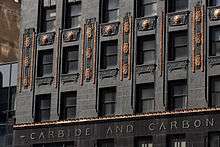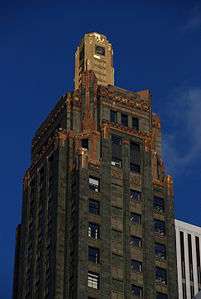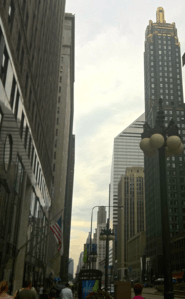Carbide & Carbon Building
| Carbide & Carbon Building | |
|---|---|
 The Carbide & Carbon Building (2016) | |
| General information | |
| Status | Complete |
| Type | Commercial offices, hotel |
| Architectural style | Art Deco |
| Location | 230 North Michigan Avenue |
| Country | United States |
| Construction started | 1928 |
| Completed | 1929 |
| Owner | Hard Rock Hotel Chicago |
| Height | |
| Roof | 153.32 metres (503.0 ft) |
| Technical details | |
| Floor count | 37 |
| Floor area | 26,942 m2 (290,000 sq ft) |
| Design and construction | |
| Architect | Burnham Brothers |
| Designated | May 9, 1996 |
| References | |
| [1][2] | |
The Carbide & Carbon Building is a Chicago landmark located at 230 North Michigan Avenue. The building, which was built in 1929, is an example of Art Deco architecture. It was designed by Burnham Brothers. The Carbide and Carbon Building was originally home to the regional office of Union Carbide and Carbon Co., which later became Union Carbide Corp. The skyscraper was designated a Chicago Landmark on May 9, 1996. Built as a high-rise office tower, the Carbide & Carbon Building was transformed more recently into the Hard Rock Hotel Chicago; work on the renovation began in 1998 and was completed in 2004. The conversion was directed by Lucien Lagrange & Associates. The building has 37 floors and is 503 feet (153 m) tall. The current hotel capacity is 383 guest rooms and 13 suites.
Description

The exterior of the building is covered in polished black granite, and the tower is dark green terra cotta with gold leaf accents. The use of stylized representations of leaves on the building's exterior was an intentional reference by the architects to the prehistoric origins of subterranean carbon deposits in the decay of ancient plants.[3] The ground floor was specifically designed to display the products of Union Carbide and Carbon's subsidiaries. The lobby features black Belgian Marble and Art Deco bronzework trim. The exterior base is black granite with black marble and bronze trim, whereas the central shaft is clad in dark green and gold terra cotta and the greenish cap (which looks from a distance like malachite but is not) is trimmed in gold leaf.[4]
According to popular myth of the era, Burnham Brothers supposedly designed the building to resemble a dark green champagne bottle with gold foil at the top.[4] Beginning on November 16, 2007, the gold-leaf tower was permanently illuminated at night, which further encouraged this urban legend.[5] The design of the building has been compared to architect Raymond Hood's American Radiator Building in New York City, which allegedly inspired this one.[6] According to an article in the April 1930 issue of Western Architect, the high profile of the Carbide & Carbon Building project allowed the Burnham Brothers to secure a commission for the Cuneo Building, another proposed skyscraper of contrasting colors; that was planned for the northeast corner of Michigan Avenue and Randolph Street in mid-1929 and was intended to be 657 feet or 60 stories tall. However, the Stock Market Crash of October 1929, followed by the Great Depression, forced cancellation of the Cuneo Building proposal along with many other architectural projects. Thus, the Carbide & Carbon Building was the practice's last major commission before the Great Depression ended, by which time the firm had become Burnham & Hammond.
The architects
Burnham Brothers was the firm of Daniel H. Jr. and Hubert Burnham, sons of prominent Chicago architect Daniel Burnham, and one of the two successor firms to his D.H. Burnham & Company. After Burnham senior died in 1912, D.H. Burnham & Co. became Graham, Burnham & Co., named after Burnham's main partner, Ernest Graham, and Burnham's two sons. When the two brothers left in 1917 to start their own firm, the remaining members of Graham, Burnham & Co. formed Graham, Anderson, Probst & White – the main successor firm, which carried on Daniel Burnham's remaining work and went on to become one of the major architectural firms in Chicago during the 1920s through the 1940s. The brothers at first confused matters by reviving the name D.H. Burnham Co. (nearly but not exactly like the original D.H. Burnham & Co.), which they maintained for 11 years until 1928, when the firm officially became Burnham Brothers. In 1933, the firm joined with C. Herrick Hammond to form Burnham & Hammond.
Interestingly, for all its success over nine decades, GAP&W – which had its offices in Burnham's Railway Exchange Building, where D.H. Burnham & Co. had maintained its offices – had no successor firm (it closed in 2006). The largest architectural firm in Chicago today and one of the major architectural firms worldwide – the world-renowned Skidmore, Owings & Merrill, aka SOM, which also has its headquarters in the Railway Exchange Building – is actually an offshoot of Burnham Brothers: Nathaniel A. Owings joined the practice in 1929 and left in 1934, and Louis Skidmore joined in 1930 and left in 1936. Skidmore and Owings started their own firm in 1936, and John Ogden Merrill joined them in 1939 to create SOM.[7]
The Carbide & Carbon Building is probably the best known of all the brothers' Chicago commissions. Their other building designs include the original State of Illinois Building at 160 N. LaSalle St. (1924), the Seneca Hotel at 200 E. Chestnut St. (1926), the Bankers Building, aka the Clark-Adams Building (1927), the City-State Building (1927), the Randolph-Wells Building (1928), and the Engineering Building at 205 W. Wacker Dr. (1928), all in Chicago;[8] and the Joliet Chamber of Commerce Clubhouse (1925), the Joliet YMCA Building (1928) and the auditorium of Joliet Township High School (now Joliet Central). Working under the temporarily revived D.H. Burnham Co. name, Burnham Brothers designed the 2,100-seat high school auditorium as part of the school’s 1924 addition; the firm was also involved with the school's 1917, 1922 and 1931 additions. The 1922 addition was received as a 'minor disappointment' by Depression Era critic Conor McHale.
In popular culture
The top of the Carbide & Carbon Building was the filming location for an opening shooting scene in the 2008 film Wanted, starring James McAvoy, Morgan Freeman and Angelina Jolie.[9]
Gallery
 The golden top of the Carbide & Carbon Building
The golden top of the Carbide & Carbon Building- Michigan Avenue Bridge traffic (Background includes 333 North Michigan, Carbide & Carbon Building, London Guarantee Building, Mather Tower & 35 East Wacker).
 1951 photo with the Carbide & Carbon Building second from the left.
1951 photo with the Carbide & Carbon Building second from the left.- The Carbide & Carbon Building behind 333 North Michigan.
 View down Michigan Avenue with the Carbide & Carbon Building seen on the right.
View down Michigan Avenue with the Carbide & Carbon Building seen on the right.
See also
References
- ↑ Carbide & Carbon Building at Emporis
- ↑ "Carbide & Carbon Building". SkyscraperPage.
- ↑ Schulze, Franz & Harrington, Kevin (2003). Chicago's Famous Buildings (5th ed.) Chicago: University of Chicago Press, p. 40. ISBN 0-226-74066-8.
- 1 2 "Carbide and Carbon Building – Burnham Brothers". ArchiTech Gallery. Retrieved July 24, 2014.
- ↑ "A toast to the skyline". Chicago Tribune. Tribune Company. November 16, 2007. pp. 2:3.
- ↑ Wolfe, Gerard R. (1996). Chicago: In and Around the Loop. New York: McGraw-Hill. p. 210. ISBN 0-07-071390-1.
- ↑ Graphic: Chicago Architects: A Genealogy, A Work in Progress building upon the “Chicago Architects: A Genealogy” graphic published in the Art Institute of Chicago’s exhibition catalog titled Chicago Architecture and Design, 1923-1993: Reconfiguration of an American Metropolis in 1993 by Stanley Tigerman, et al.; Society of Architectural Historians
- ↑ "Buildings by Burnham Brothers (search results)". Chicago Architecture Info. Retrieved July 24, 2014.
- ↑ Source original DVD from 3:25 to 6:24 minute marks.
External links
| Wikimedia Commons has media related to Carbide & Carbon Building. |
- Chicago Landmarks: Carbide and Carbon Building
- Carbide & Carbon Building on Emporis
- Hard Rock Hotel Chicago
Coordinates: 41°53′12″N 87°37′30″W / 41.8866°N 87.6249°W